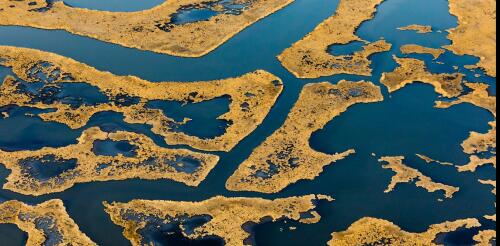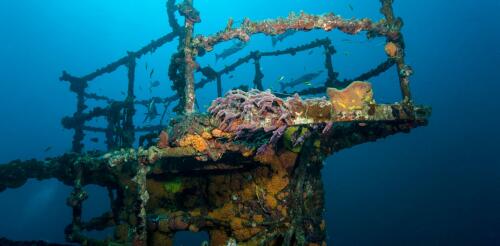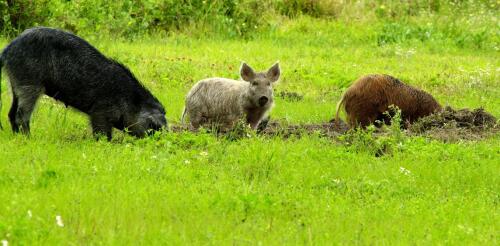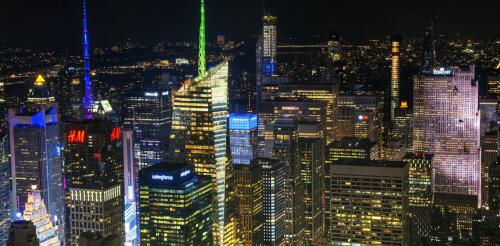Habitat
Wetlands have flourished along the world’s coastlines for thousands of years, playing valuable roles in the lives of people and wildlife. They protect the land from storm surge, stop seawater from contaminating drinking water supplies, and create habitat for birds, fish and threatened species. Much of that may be gone in a matter of decades. As the planet warms, sea level rises at an ever-faster rate. Wetlands have generally kept pace by building upward and creeping inland a few meters per year. But raised roadbeds, cities, farms and increasing land elevation can leave wetlands with nowhere to go. Sea-level rise projections for midcentury suggest the waterline will be shifting 15 to 100 times faster than wetland migration has been clocked. Many wetlands, like these on Cape Cod, are now bordered by human infrastructure, including towns and roads. Lance Cheung/USDA I have been studying coastal g...
All of the saltwater bodies on Earth make up one big ocean. But within it, there is infinite variety – just ask any scuba diver. Some spots have more coral, more sea turtles, more fish, more life. “I’ve been diving in many places around the world, and there are few locations like the Fuvahmulah Atoll in the Maldives,” Amanda Batlle-Morera, a research assistant with the Important Shark and Ray Areas project, told me. “You can observe tiger sharks, thresher sharks, scalloped hammerheads, oceanic manta rays and more, without throwing out bait to attract them.” Identifying areas like Fuvahmulah that are especially important to certain species is a long-standing strategy for protecting threatened land animals, birds and marine mammals, such as whales and dolphins. Now our team of marine conservation scientists at the Important Shark and Ray Areas project is using it to help protect sharks and their relatives. I am a marine conservation biologis...
When people hear about underwater reefs, they usually picture colorful gardens created from coral. But some reefs are anchored to much more unusual foundations. For more than a century, people have placed a wide assortment of objects on the seafloor off the U.S. coast to provide habitat for marine life and recreational opportunities for fishing and diving. Artificial reefs have been created from decommissioned ships, chicken transport cages, concrete pipes, rail cars and more. We study how ocean-dwelling fish use artificial reefs in the U.S. and beyond. Through our research, we have learned that artificial reefs can be hot spots for large predatory fish such as groupers and jacks. They also can serve as stepping stones for reef fish expanding their range northward with warming water temperatures and as rest stops for sharks. Artificial reefs can be strategically designed and placed to optimize fish habitat. But although they provide valuable ecological services, no one has in...
They go by many names – pigs, hogs, swine, razorbacks – but whatever you call them, wild pigs (Sus scrofa) are one of the most damaging invasive species in North America. They cause millions of dollars in crop damage yearly and harbor dozens of pathogens that threaten humans and pets, as well as meat production systems. Although wild pigs have been present in North America for centuries, their populations have rapidly expanded over the past several decades. Recent studies estimate that since the 1980s the wild pig population in the United States has nearly tripled and expanded from 18 to 35 states. More recently, they have spread rapidly across Canada, and these populations are threatening to invade the U.S. from the north. The wild pigs in Canada are unique because they were originally crossbred by humans to be larger and more cold-hardy than their feral cousins to the south. This suite of traits has earned them the name “super pigs” for good reason. Adu...
Light pollution has steadily intensified and expanded from urban areas, and with the advent of LED lighting, it is growing in North America by up to 10% per year, as measured by the visibility of stars in the night sky. In our recent study, we found that the glow from cities and urban outskirts can powerfully attract migratory birds, drawing them into developed areas where food is scarcer and they face threats such as colliding with glass buildings. Each spring and fall, migratory birds journey to or from their breeding grounds, sometimes traveling thousands of miles. En route, most birds need to make stopovers to rest and feed. Some species burn off half of their body mass during migration. Migratory stopover sites are not random, and birds typically use the same locations from year to year. Because migration takes place on a continental scale, with billions of birds crossing North America each migratory season, it’s important for scientists to understand what attracts bi...




